belt TOYOTA FJ CRUISER 2009 1.G Owners Manual
[x] Cancel search | Manufacturer: TOYOTA, Model Year: 2009, Model line: FJ CRUISER, Model: TOYOTA FJ CRUISER 2009 1.GPages: 432, PDF Size: 8.71 MB
Page 1 of 432
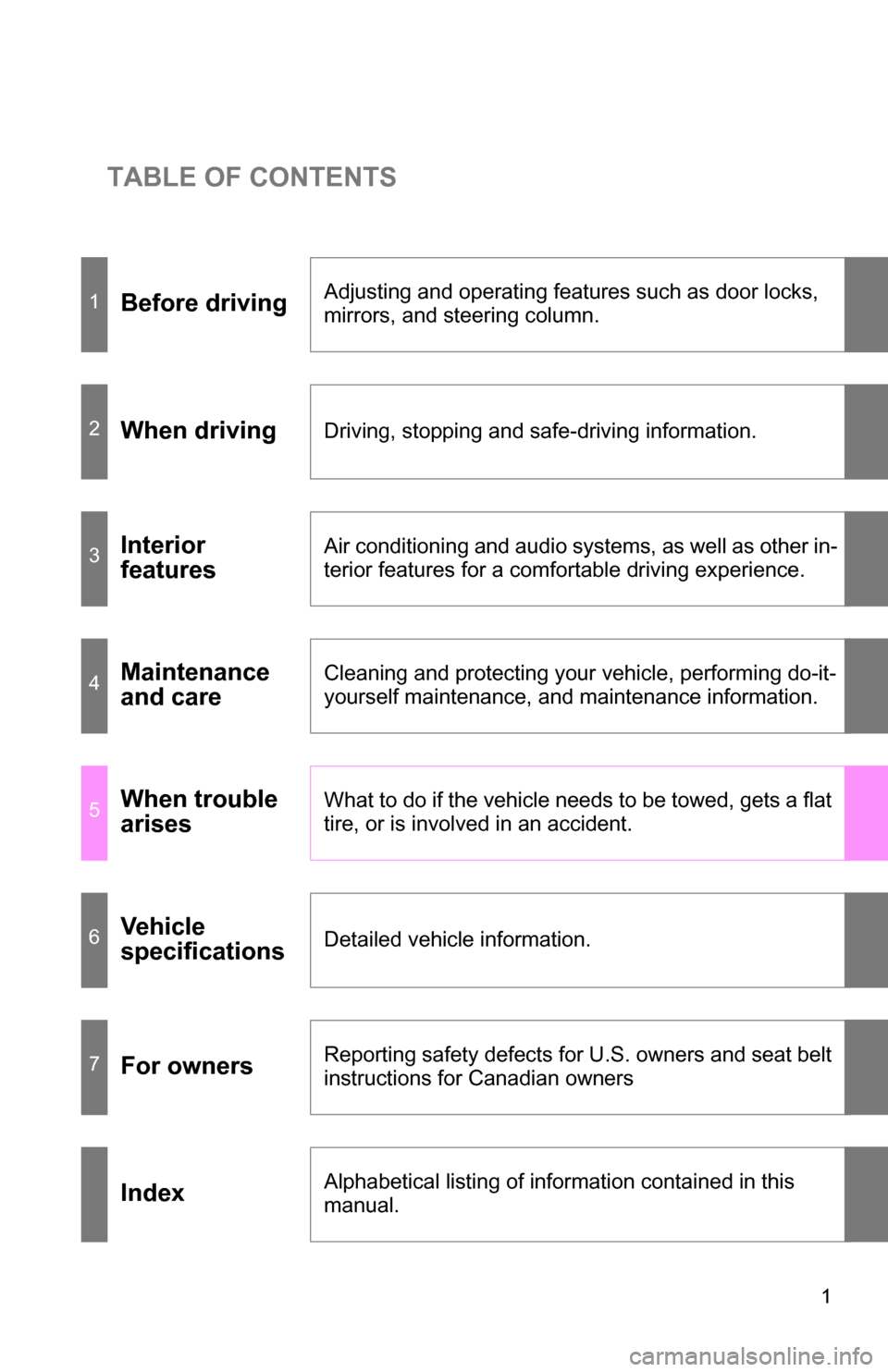
TABLE OF CONTENTS
1
1Before drivingAdjusting and operating features such as door locks,
mirrors, and steering column.
2When drivingDriving, stopping and safe-driving information.
3Interior
featuresAir conditioning and audio systems, as well as other in-
terior features for a comfortable driving experience.
4Maintenance
and careCleaning and protecting your vehicle, performing do-it-
yourself maintenance, and maintenance information.
5When trouble
arisesWhat to do if the vehicle needs to be towed, gets a flat
tire, or is involved in an accident.
6Vehicle
specificationsDetailed vehicle information.
7For ownersReporting safety defects for U.S. owners and seat belt
instructions for Canadian owners
IndexAlphabetical listing of information contained in this
manual.
Page 2 of 432

TABLE OF CONTENTSIndex
2
1-1. Key informationKeys ..................................... 28
1-2. Opening, closing and locking
the doors
Wireless remote control ...... 30
Side doors ............................ 33
Access doors........................ 36
Back door ............................. 38
Glass hatch .......................... 41
1-3. Adjustable components
(seats, mirrors, steering
wheel)
Front seats ........................... 43
Rear seats ............................ 45
Head restraints ..................... 50
Seat belts ............................. 52
Steering wheel ..................... 58
Anti-glare inside rear view mirror .................................. 59
Outside rear view mirrors ..... 63
1-4. Opening a nd closing the
windo ws
Power windows .................... 66
1-5. Refueling Opening the fuel tank cap .... 68 1-6. Theft deterrent system
Engine immobilizer system ................................ 72
Theft prevention labels (U.S.A.)............................... 74
1-7. Safety information Correct driving posture ......... 75
SRS airbags ......................... 77
Front passenger occupant classification system ........... 90
Child restraint systems ......... 95
Installing child restraints ....... 99
2-1. Driving procedures Driving the vehicle .............. 110
Engine (ignition) switch....... 120
Automatic
Transmission...... 123
Manual Transmission ......... 125
Turn signal lever ................. 127
Parking brake ..................... 128
Horn .................................... 130
2-2. Instrument cluster Gauges and meters ............ 131
Indicators and warning lights ................................. 134
Accessory meter ................. 137
2-3. Operating the li ghts and
wipers
Headlight switch ................. 139
Windshield wipers and washer .............................. 141
1Before driving
2When driving
Page 5 of 432

1
2
3
4
5
6
7
5
6-1. SpecificationsMaintenance data (fuel, oil level, etc.) ......................... 384
Fuel information .................. 394
Tire information ................... 397
6-2. Customization Customizable features ........ 408
Items to initialize ................. 410
Reporting safety defects for U.S. owners ...................... 412
Seat belt instructions for Canadian owners
(in French) ........................ 413
Abbreviation list ........................ 416
Alphabetical index ..................... 418
What to do if... ............................ 426
6Vehicle specifications
7For owners
Index
Page 10 of 432
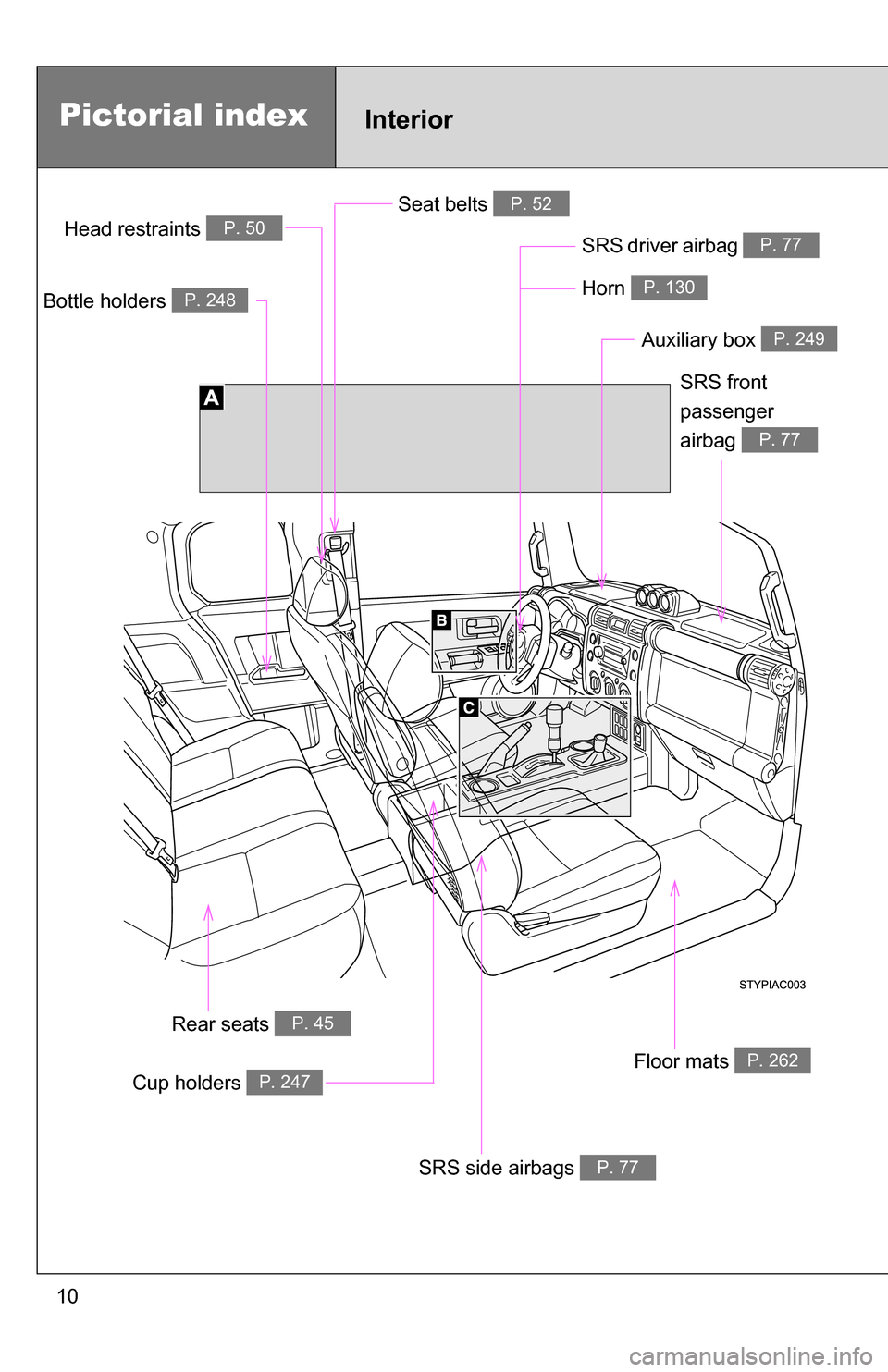
10
Pictorial indexInterior
Seat belts P. 52
SRS driver airbag P. 77Head restraints P. 50
Bottle holders P. 248
Cup holders P. 247
SRS side airbags P. 77
Floor mats P. 262
SRS front
passenger
airbag
P. 77
Auxiliary box P. 249
Rear seats P. 45
Horn P. 130
Page 22 of 432
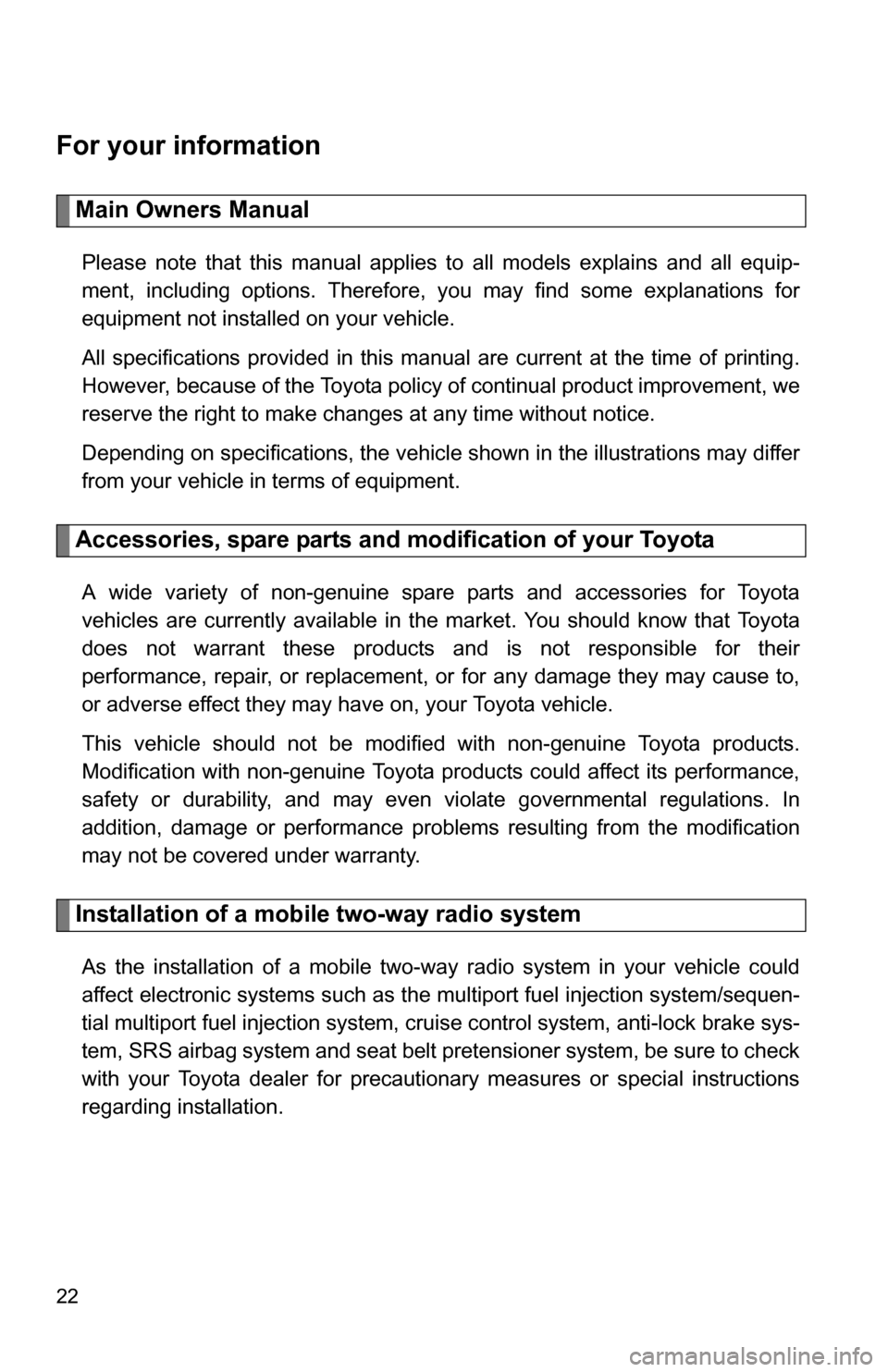
22
For your information
Main Owners Manual
Please note that this manual applies to all models explains and all equip-
ment, including options. Therefore, you may find some explanations for
equipment not installed on your vehicle.
All specifications provided in this manual are current at the time of printing.
However, because of the Toyota policy of continual product improvement, we
reserve the right to make changes at any time without notice.
Depending on specifications, the vehicle shown in the illustrations may differ
from your vehicle in terms of equipment.
Accessories, spare parts and modification of your Toyota
A wide variety of non-genuine spare parts and accessories for Toyota
vehicles are currently available in the market. You should know that Toyota
does not warrant these products and is not responsible for their
performance, repair, or replacement, or for any damage they may cause to,
or adverse effect they may have on, your Toyota vehicle.
This vehicle should not be modified with non-genuine Toyota products.
Modification with non-genuine Toyota products could affect its performance,
safety or durability, and may even violate governmental regulations. In
addition, damage or performance problems resulting from the modification
may not be covered under warranty.
Installation of a mobile two-way radio system
As the installation of a mobile two-way radio system in your vehicle could
affect electronic systems such as the multiport fuel injection system/sequen-
tial multiport fuel injection system, cruise control system, anti-lock brake sys-
tem, SRS airbag system and seat belt pretensioner system, be sure to check
with your Toyota dealer for precautionary measures or special instructions
regarding installation.
Page 23 of 432
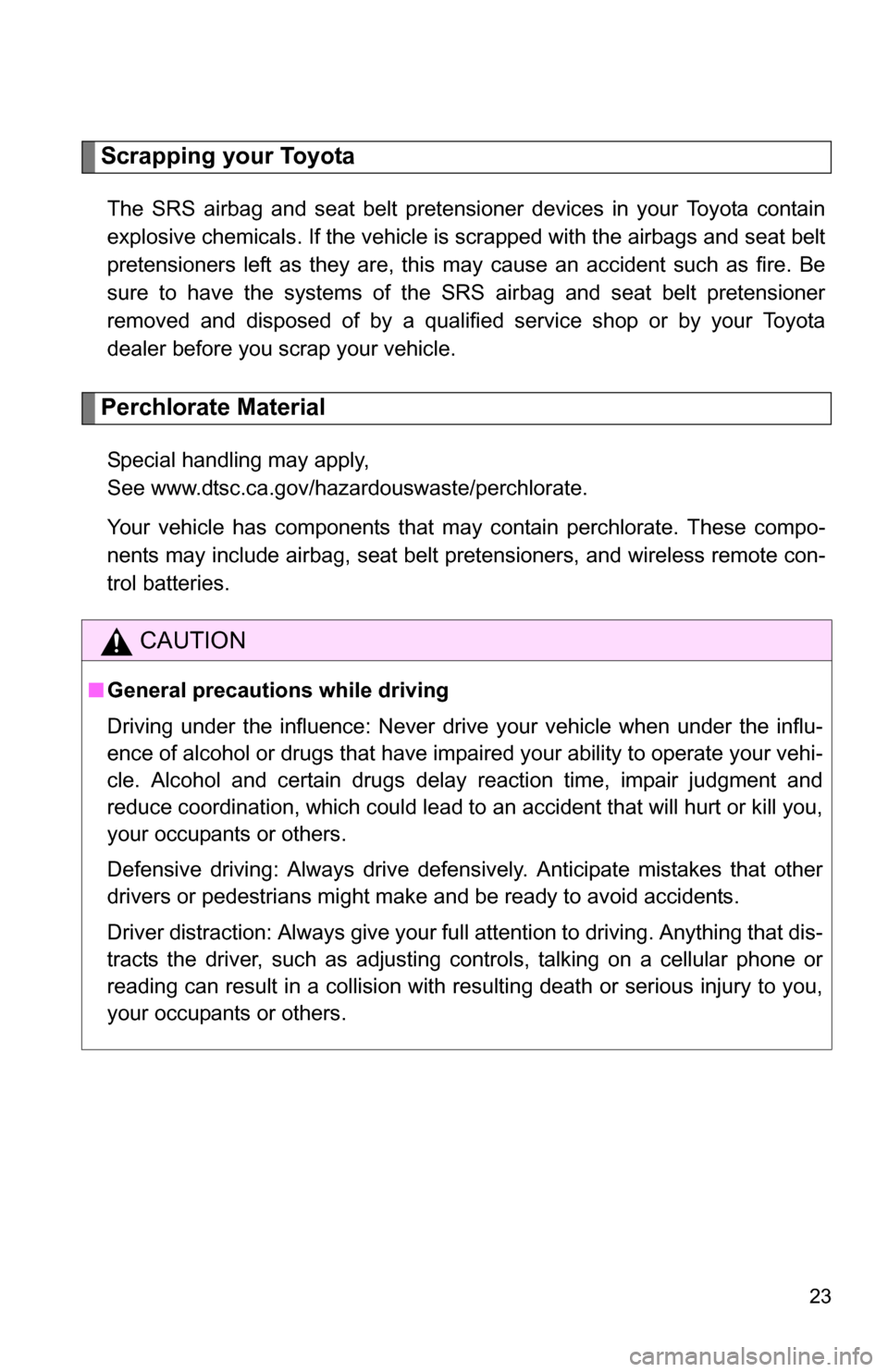
23
Scrapping your Toyota
The SRS airbag and seat belt pretensioner devices in your Toyota contain
explosive chemicals. If the vehicle is scrapped with the airbags and seat belt
pretensioners left as they are, this may cause an accident such as fire. Be
sure to have the systems of the SRS airbag and seat belt pretensioner
removed and disposed of by a qualified service shop or by your Toyota
dealer before you scrap your vehicle.
Perchlorate Material
Special handling may apply,
See www.dtsc.ca.gov/hazardouswaste/perchlorate.
Your vehicle has components that may contain perchlorate. These compo-
nents may include airbag, seat belt pretensioners, and wireless remote con-
trol batteries.
CAUTION
■General precautions while driving
Driving under the influence: Never drive your vehicle when under the influ-
ence of alcohol or drugs that have impaired your ability to operate your vehi-
cle. Alcohol and certain drugs delay reaction time, impair judgment and
reduce coordination, which could lead to an accident that will hurt or kill you,
your occupants or others.
Defensive driving: Always drive defensively. Anticipate mistakes that other
drivers or pedestrians might make and be ready to avoid accidents.
Driver distraction: Always give your full attention to driving. Anything that dis-
tracts the driver, such as adjusting controls, talking on a cellular phone or
reading can result in a collision with resulting death or serious injury to you,
your occupants or others.
Page 27 of 432

Before driving1
27
1-1. Key informationKeys ................................... 28
1-2. Opening, closing and locking the doors
Wireless remote control ... 30
Side doors .......................... 33
Access doors ..................... 36
Back door ........................... 38
Glass hatch ........................ 41
1-3. Adjustable components (seats, mirrors, steering
wheel)
Front seats ......................... 43
Rear seats.......................... 45
Head restraints................... 50
Seat belts ........................... 52
Steering wheel ................... 58
Anti-glare inside rear view mirror ............................... 59
Outside rear view mirrors ... 63
1-4. Opening and closing the windows
Power windows .................. 66
1-5. Refueling Opening the fuel tank cap ................................... 68 1-6. Theft deterrent system
Engine immobilizer system ............................. 72
Theft prevention labels (U.S.A.) ............................ 74
1-7. Safety information Correct driving posture....... 75
SRS airbags ....................... 77
Front passenger occupant classification system ........ 90
Child restraint systems....... 95
Installing child restraints..... 99
Page 35 of 432

35
1-2. Opening, closing and locking the doors
1
Before driving
CAUTION
■
To prevent an accident
Observe the following precautions while driving the vehicle.
Failing to do so may result in a door opening and an occupant falling out,
resulting in death or serious injury.
●Always use a seat belt.
● Always lock all doors.
● Ensure that all doors are properly closed.
● Do not pull the inside handle of the doors while driving.
The doors may be opened and the passengers are thrown out of the vehi-
cle and it may result in serious injury or death.
Be especially careful for the side doors, the doors may be opened even if
the inside lock buttons are in locked position.
Page 44 of 432

44 1-3. Adjustable components (seats, mirrors, steering wheel)
■Active head restraints
Even small forces applied to the seatback may cause the head restraint to
move. Pushing up a locked head restraint forcibly may show the head
restraint inner structure. These do not indicate problems.
■ Waterproof and water-repellent seats
Waterproof and water-repellent seats are installed in your vehicle; however,
the water-repellent effect does not last forever.
CAUTION
■Seat adjustment
●Do not recline the seat more than necessary when the vehicle is in motion
to reduce the risk of sliding under the lap belt.
If the seat is too reclined, the lap belt may slide past the hips and apply
restraint forces directly to the abdomen or your neck may contact the
shoulder belt, increasing the risk of death or serious injury in the event of
an accident.
● After adjusting the seat, make sure that the seat is locked in position.
Inner
structure
During
rear-end
collision
Page 45 of 432
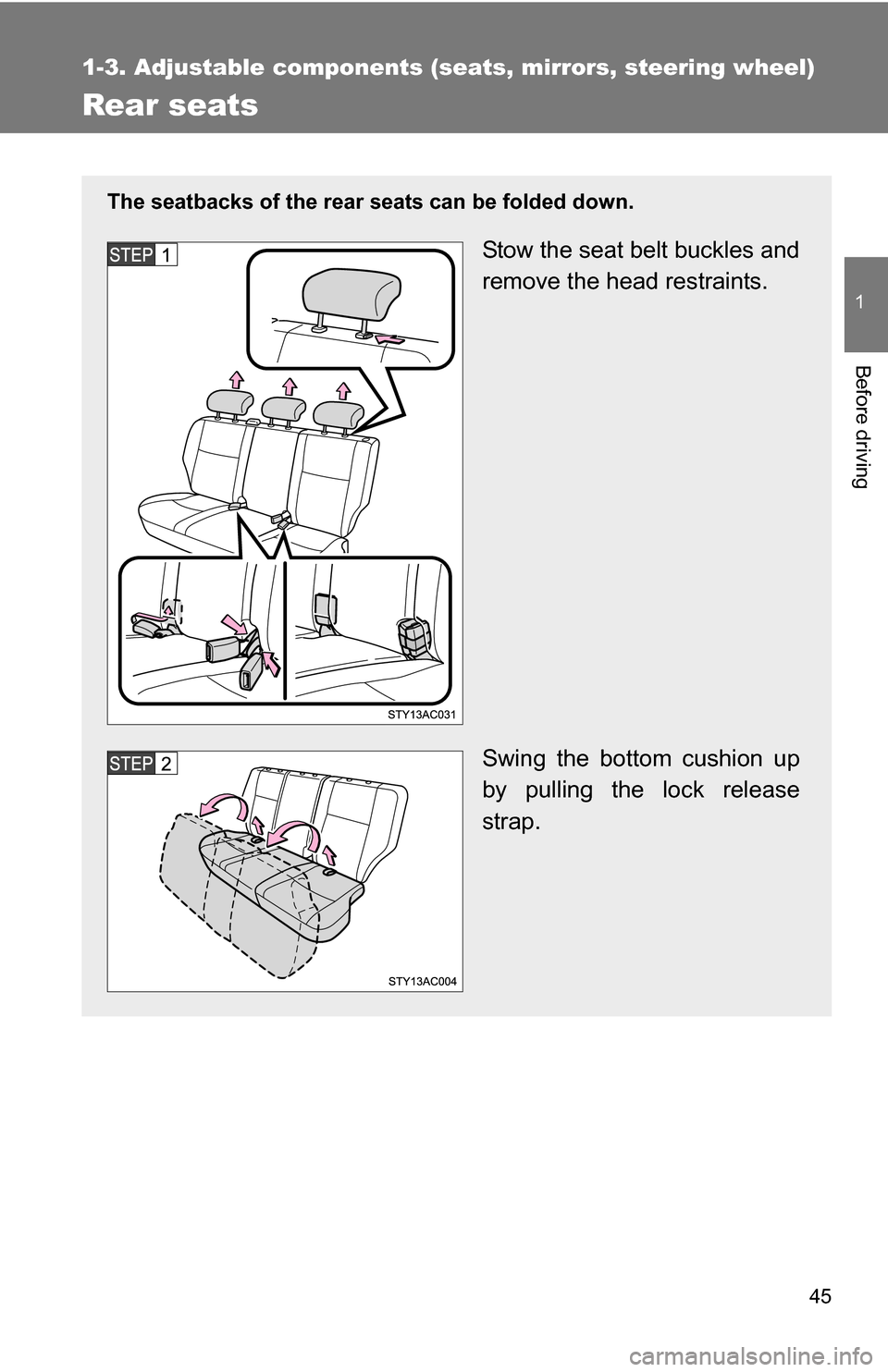
45
1
1-3. Adjustable components (seats, mirrors, steering wheel)
Before driving
Rear seats
The seatbacks of the rear seats can be folded down.
Stow the seat belt buckles and
remove the head restraints.
Swing the bottom cushion up
by pulling the lock release
strap.